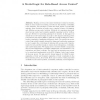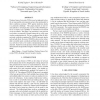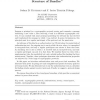119 search results - page 22 / 24 » Formal Methods for Assuring Security of Protocols |
ICALP
2010
Springer
14 years 6 days ago
2010
Springer
Knowledge extraction is a fundamental notion, modeling machine possession of values (witnesses) in a computational complexity sense and enabling one to argue about the internal st...
MMMACNS
2005
Springer
14 years 27 days ago
2005
Springer
Making correct access-control decisions is central to security, which in turn requires accounting correctly for the identity, credentials, roles, authority, and privileges of users...
ICASSP
2011
IEEE
12 years 11 months ago
2011
IEEE
Wireless Sensor Networks (WSNs) may be deployed in hostile or inaccessible environments and are often unattended. In these conditions securing a WSN against malicious attacks is a...
CCS
2011
ACM
12 years 7 months ago
2011
ACM
We consider security properties of cryptographic protocols that can be modeled using the notion of trace equivalence. The notion of equivalence is crucial when specifying privacy-...
TCS
2002
13 years 7 months ago
2002
Suppose a principal in a cryptographic protocol creates and transmits a message containing a new value v, later receiving v back in a different cryptographic context. It can concl...



